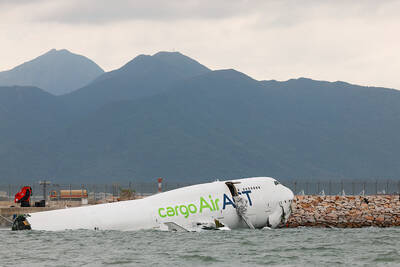As federal flood-control officials directed efforts on Thursday to block off the 17th Street Canal, the source of most of the water swamping New Orleans, they faced growing criticism over decades of missed opportunities to prevent precisely this kind of disaster.
In interviews and a telephone conference call with reporters, senior officials and engineers from up and down the ranks of the Army Corps of Engineers conceded that they had no ability to detect quickly small breaches in the matrix of 560km of levees around the city.
Unless such holes can be blocked early, the punch of storm-driven waters will almost invariably rip away at the edges, widening the breach.
The officials and engineers said that after they had found the widening gap in the concrete wall that lines the eastern side of the canal, they had no quick-response plan to repair it.
Even as they tried to improvise a solution, while fresh torrents of water steadily inundated neighborhood after neighborhood, their efforts were impeded by a lack of heavy helicopters, most of which had been dispatched by federal emergency management officials to rescue stranded residents.
"The first priority of the rotary-winged aircraft was to rescue people," Lieutenant General Carl Strock, head of the US Army Corps of Engineers, said in the conference call. "Plugging the gap was a lower priority."
The accumulation of 40 years of compromises of that sort on Thursday resulted in a mixture of grief, frustration and defensiveness from the Corps, which has long been given a mission far broader than its budget.
Ultimately, the Army Corps was being directed, along with 15 other agencies, by the Federal Emergency Management Agency (FEMA), Strock said.
"It is FEMA who is really calling the shots and setting priorities here," he said.
Strock also defended the administration against the idea that spending on Iraq had diminished the Corps capacity to deal with domestic threats like the hurricane.
"I do not see that to be the case," he said.
"We deeply regret the loss of life associated with this," Strock said. "We are committed to doing whatever we can right now to stop the flow of waters and get the city on the road to recovery."
Alfred Naomi, a Corps senior project manager in the New Orleans district, said the New Orleans protection system was a vexing mix: It met the standards that had long ago been agreed on, but it was known to be inadequate.
"This storm was much greater than protection we were authorized to provide," he said.
While Congress appropriated more than US$4.7 billion for the Corps of Engineers this year, the amount spent on the New Orleans levee projects highlighted by the flooding was relatively small. The Lake Pontchartrain project drew about US$5.7 million and that was almost US$2 million more than what US President George W. Bush recommended in his budget.
In the last five years, Congress has repeatedly raised the amount of money for levee projects in New Orleans over what Bush requested, according to numbers provided by Senate Republicans.
In fact, lawmakers repeatedly enlarged the corps' budget overall -- but it was always still far below what corps engineers said would finish the job.
Adam Hughes, a budget policy analyst with OMB Watch, said such tradeoffs far too often err on the side of serving short-term needs and discounting long-term risks. And now, he said, the destruction of New Orleans made an earlier investment in bigger berms and other protections -- all part of that gray universe of what bureaucrats call infrastructure -- look like a bargain.
"This is a classic example of what under-funding infrastructure can do," Hughes said.

‘MOTHER’ OF THAILAND: In her glamorous heyday in the 1960s, former Thai queen Sirikit mingled with US presidents and superstars such as Elvis Presley The year-long funeral ceremony of former Thai queen Sirikit started yesterday, with grieving royalists set to salute the procession bringing her body to lie in state at Bangkok’s Grand Palace. Members of the royal family are venerated in Thailand, treated by many as semi-divine figures, and lavished with glowing media coverage and gold-adorned portraits hanging in public spaces and private homes nationwide. Sirikit, the mother of Thai King Vajiralongkorn and widow of the nation’s longest-reigning monarch, died late on Friday at the age of 93. Black-and-white tributes to the royal matriarch are being beamed onto towering digital advertizing billboards, on

Indonesia was to sign an agreement to repatriate two British nationals, including a grandmother languishing on death row for drug-related crimes, an Indonesian government source said yesterday. “The practical arrangement will be signed today. The transfer will be done immediately after the technical side of the transfer is agreed,” the source said, identifying Lindsay Sandiford and 35-year-old Shahab Shahabadi as the people being transferred. Sandiford, a grandmother, was sentenced to death on the island of Bali in 2013 after she was convicted of trafficking drugs. Customs officers found cocaine worth an estimated US$2.14 million hidden in a false bottom in Sandiford’s suitcase when

POWER ABUSE WORRY: Some people warned that the broad language of the treaty could lead to overreach by authorities and enable the repression of government critics Countries signed their first UN treaty targeting cybercrime in Hanoi yesterday, despite opposition from an unlikely band of tech companies and rights groups warning of expanded state surveillance. The new global legal framework aims to bolster international cooperation to fight digital crimes, from child pornography to transnational cyberscams and money laundering. More than 60 countries signed the declaration, which means it would go into force once ratified by those states. UN Secretary-General Antonio Guterres described the signing as an “important milestone,” and that it was “only the beginning.” “Every day, sophisticated scams destroy families, steal migrants and drain billions of dollars from our economy...

CAUSE UNKNOWN: Weather and runway conditions were suitable for flight operations at the time of the accident, and no distress signal was sent, authorities said A cargo aircraft skidded off the runway into the sea at Hong Kong International Airport early yesterday, killing two ground crew in a patrol car, in one of the worst accidents in the airport’s 27-year history. The incident occurred at about 3:50am, when the plane is suspected to have lost control upon landing, veering off the runway and crashing through a fence, the Airport Authority Hong Kong said. The jet hit a security patrol car on the perimeter road outside the runway zone, which then fell into the water, it said in a statement. The four crew members on the plane, which